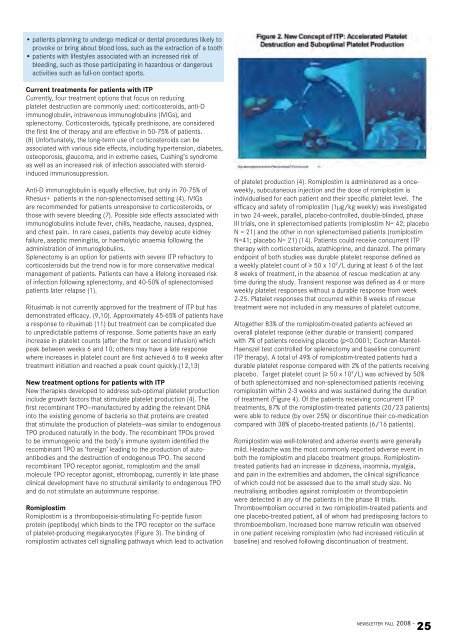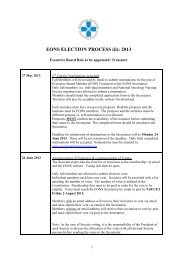Immune Thrombocytopenic Purpura - the European Oncology ...
Immune Thrombocytopenic Purpura - the European Oncology ...
Immune Thrombocytopenic Purpura - the European Oncology ...
You also want an ePaper? Increase the reach of your titles
YUMPU automatically turns print PDFs into web optimized ePapers that Google loves.
• patients planning to undergo medical or dental procedures likely to<br />
provoke or bring about blood loss, such as <strong>the</strong> extraction of a tooth<br />
• patients with lifestyles associated with an increased risk of<br />
bleeding, such as those participating in hazardous or dangerous<br />
activities such as full-on contact sports.<br />
Current treatments for patients with ITP<br />
Currently, four treatment options that focus on reducing<br />
platelet destruction are commonly used: corticosteroids, anti-D<br />
immunoglobulin, intravenous immunoglobulins (IVIGs), and<br />
splenectomy. Corticosteroids, typically prednisone, are considered<br />
<strong>the</strong> first line of <strong>the</strong>rapy and are effective in 50-75% of patients.<br />
(8) Unfortunately, <strong>the</strong> long-term use of corticosteroids can be<br />
associated with various side effects, including hypertension, diabetes,<br />
osteoporosis, glaucoma, and in extreme cases, Cushing’s syndrome<br />
as well as an increased risk of infection associated with steroidinduced<br />
immunosuppression.<br />
Anti-D immunoglobulin is equally effective, but only in 70-75% of<br />
Rhesus+ patients in <strong>the</strong> non-splenectomised setting (4). IVIGs<br />
are recommended for patients unresponsive to corticosteroids, or<br />
those with severe bleeding (7). Possible side effects associated with<br />
immunoglobulins include fever, chills, headache, nausea, dyspnea,<br />
and chest pain. In rare cases, patients may develop acute kidney<br />
failure, aseptic meningitis, or haemolytic anaemia following <strong>the</strong><br />
administration of immunoglobulins.<br />
Splenectomy is an option for patients with severe ITP refractory to<br />
corticosteroids but <strong>the</strong> trend now is for more conservative medical<br />
management of patients. Patients can have a lifelong increased risk<br />
of infection following splenectomy, and 40-50% of splenectomised<br />
patients later relapse (1).<br />
Rituximab is not currently approved for <strong>the</strong> treatment of ITP but has<br />
demonstrated efficacy. (9,10). Approximately 45-65% of patients have<br />
a response to rituximab (11) but treatment can be complicated due<br />
to unpredictable patterns of response. Some patients have an early<br />
increase in platelet counts (after <strong>the</strong> first or second infusion) which<br />
peak between weeks 6 and 10; o<strong>the</strong>rs may have a late response<br />
where increases in platelet count are first achieved 6 to 8 weeks after<br />
treatment initiation and reached a peak count quickly.(12,13)<br />
New treatment options for patients with ITP<br />
New <strong>the</strong>rapies developed to address sub-optimal platelet production<br />
include growth factors that stimulate platelet production (4). The<br />
first recombinant TPO—manufactured by adding <strong>the</strong> relevant DNA<br />
into <strong>the</strong> existing genome of bacteria so that proteins are created<br />
that stimulate <strong>the</strong> production of platelets—was similar to endogenous<br />
TPO produced naturally in <strong>the</strong> body. The recombinant TPOs proved<br />
to be immunogenic and <strong>the</strong> body’s immune system identified <strong>the</strong><br />
recombinant TPO as ‘foreign’ leading to <strong>the</strong> production of autoantibodies<br />
and <strong>the</strong> destruction of endogenous TPO. The second<br />
recombinant TPO receptor agonist, romiplostim and <strong>the</strong> small<br />
molecule TPO receptor agonist, eltrombopag, currently in late phase<br />
clinical development have no structural similarity to endogenous TPO<br />
and do not stimulate an autoimmune response.<br />
Romiplostim<br />
Romiplostim is a thrombopoeisis-stimulating Fc-peptide fusion<br />
protein (peptibody) which binds to <strong>the</strong> TPO receptor on <strong>the</strong> surface<br />
of platelet-producing megakaryocytes (Figure 3). The binding of<br />
romiplostim activates cell signalling pathways which lead to activation<br />
of platelet production (4). Romiplostim is administered as a onceweekly,<br />
subcutaneous injection and <strong>the</strong> dose of romiplostim is<br />
individualised for each patient and <strong>the</strong>ir specific platelet level. The<br />
efficacy and safety of romiplostim (1μg/kg weekly) was investigated<br />
in two 24-week, parallel, placebo-controlled, double-blinded, phase<br />
III trials, one in splenectomised patients (romiplostim N= 42; placebo<br />
N = 21) and <strong>the</strong> o<strong>the</strong>r in non splenectomised patients (romiplostim<br />
N=41; placebo N= 21) (14). Patients could receive concurrent ITP<br />
<strong>the</strong>rapy with corticosteroids, azathioprine, and danazol. The primary<br />
endpoint of both studies was durable platelet response defined as<br />
a weekly platelet count of ≥ 50 x 10 9 /L during at least 6 of <strong>the</strong> last<br />
8 weeks of treatment, in <strong>the</strong> absence of rescue medication at any<br />
time during <strong>the</strong> study. Transient response was defined as 4 or more<br />
weekly platelet responses without a durable response from week<br />
2-25. Platelet responses that occurred within 8 weeks of rescue<br />
treatment were not included in any measures of platelet outcome.<br />
Altoge<strong>the</strong>r 83% of <strong>the</strong> romiplostim-treated patients achieved an<br />
overall platelet response (ei<strong>the</strong>r durable or transient) compared<br />
with 7% of patients receiving placebo (p
















